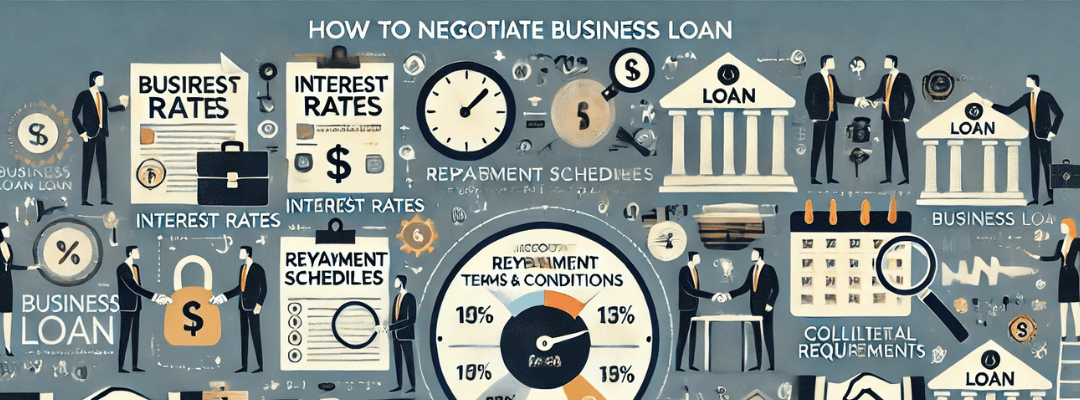Negotiating the terms and conditions of a business loan is crucial for securing the best possible deal that aligns with your business needs and minimizes financial strain. Effective negotiation can help you obtain favorable interest rates, repayment terms, and fees. Here’s a step-by-step guide on how to negotiate business loan terms and conditions:
1. Build a Strong Business Case
- Present a Detailed Business Plan: To increase your bargaining power, prepare a comprehensive business plan that includes cash flow projections, revenue forecasts, and a clear outline of how the loan will be used to grow or stabilize your business. Lenders are more likely to negotiate if they see that your business has a solid strategy for generating revenue and repaying the loan.
- Showcase Strong Financial Health: Provide financial statements, tax returns, balance sheets, and cash flow statements that demonstrate the financial health and profitability of your business. A solid financial record gives lenders confidence that you are a low-risk borrower, increasing your chances of negotiating better terms.
2. Improve Your Business and Personal Credit Score
- Check and Improve Credit Scores: A good credit score—both business and personal—provides leverage in negotiating better loan terms, such as lower interest rates or more flexible repayment options. If your credit score is low, work on improving it before applying for the loan by paying off debts and clearing any errors on your credit report.
- Highlight Positive Credit History: If your business or personal credit report reflects timely repayment of previous loans, use this to negotiate favorable terms, emphasizing your reliability as a borrower.
3. Compare Loan Offers from Multiple Lenders
- Get Multiple Loan Offers: Don’t settle for the first loan offer you receive. Approach several banks, credit unions, or non-banking financial companies (NBFCs) and ask for loan quotes. This will give you a benchmark for interest rates, fees, and loan terms, and provide you with leverage to negotiate better terms with your preferred lender.
- Use Competitive Offers as Leverage: If one lender offers a better rate or terms than another, use this as leverage to negotiate with your preferred lender. Many lenders are willing to match or beat competitive offers to win your business.
4. Negotiate for Lower Interest Rates
- Ask for Reduced Interest Rates: If your business has a strong credit profile, a steady revenue stream, and a solid financial history, negotiate for lower interest rates. Even a small reduction in the interest rate can result in significant savings over the life of the loan.
- Fixed vs. Variable Rates: Depending on market conditions and your business needs, negotiate for either a fixed or variable interest rate. A fixed rate offers stability and predictable payments, while a variable rate may provide lower rates initially but with the potential for future increases.
5. Extend or Adjust Repayment Terms
- Request Flexible Repayment Schedules: Depending on your cash flow and revenue projections, negotiate for a repayment schedule that aligns with your business’s financial capabilities. Options include monthly, quarterly, or even seasonal payments, which can help match repayment with your cash flow patterns.
- Negotiate for Longer Repayment Periods: A longer repayment period will reduce the monthly or quarterly repayment amount, which can ease the financial burden on your business. However, keep in mind that extending the loan tenure will result in paying more interest over time.
- Early Repayment Flexibility: Ask for flexible repayment options, such as the ability to pay off the loan early without penalties. Early repayment can save your business on interest costs.
6. Minimize or Eliminate Fees
- Reduce or Waive Processing Fees: Many lenders charge processing fees (usually a percentage of the loan amount). Negotiate to reduce or eliminate these fees, especially if you have a strong credit history or existing relationships with the lender.
- Negotiate Other Fees: In addition to processing fees, lenders may charge administrative fees, legal fees, or origination fees. Ask for these fees to be reduced or waived, especially if the loan amount is substantial or if you’re an established client.
- Prepayment and Late Payment Penalties: Ensure there are minimal or no penalties for prepaying the loan or making extra payments. Also, negotiate for leniency on late payment fees, especially if your business has fluctuating cash flows.
7. Collateral and Security Negotiation
- Negotiate Collateral Terms: Many business loans require collateral, such as real estate, equipment, or inventory. If the lender asks for specific collateral, negotiate to provide an asset that best fits your business situation and minimizes your risk.
- Loan-to-Value (LTV) Ratio: Negotiate the LTV ratio for secured loans, which determines how much the lender will lend relative to the value of the collateral. A lower LTV ratio means you can borrow more with the same collateral.
- Avoid Personal Guarantees: Many lenders require business owners to provide personal guarantees, which means your personal assets are at risk if the business defaults. Negotiate to limit or remove personal guarantees, especially if your business has sufficient collateral or a strong credit profile.
8. Leverage Existing Relationships
- Use Long-Term Banking Relationships: If you already have an existing relationship with a bank or lender, leverage it to negotiate better terms. Lenders are often more flexible with loyal customers who have a good repayment history.
- Preferred Customer Discounts: Some banks offer preferred rates or lower fees for long-term or high-value clients. Ask if your business qualifies for any discounts or special offers.
9. Ask for Grace Periods and Payment Holidays
- Negotiate for a Grace Period: A grace period allows you to defer payments for a certain period (usually at the start of the loan) without penalties. This can provide breathing room for your business to stabilize or generate revenue before starting repayments.
- Payment Holidays: If your business has seasonal fluctuations, negotiate for payment holidays (temporary breaks in payments) during slow periods or cash flow shortfalls.
10. Custom Loan Products
- Tailored Loan Solutions: Some lenders offer customized loan products based on your specific business needs, such as equipment financing, working capital loans, or invoice financing. Negotiate for a loan structure that best aligns with your business goals and cash flow requirements.
- Specialized Loan Programs: If your business operates in a specific industry (e.g., agriculture, healthcare, or manufacturing), inquire about industry-specific loan programs with favorable terms for that sector.
11. Ensure Clarity on Covenants and Conditions
- Review Loan Covenants: Loan covenants are conditions set by the lender, such as maintaining a certain debt-to-income ratio or not taking on additional debt. Negotiate covenants that are reasonable and achievable for your business. Too strict covenants can limit your business operations.
- Limit Restrictive Clauses: Ensure that loan conditions do not overly restrict your business activities, such as prohibiting you from acquiring new assets or taking on other forms of debt. Negotiate to minimize restrictive clauses.
12. Be Willing to Walk Away
- Be Prepared to Leave the Table: If a lender is unwilling to negotiate favorable terms or offers unfavorable conditions, be prepared to walk away and explore options with other lenders. Demonstrating that you have other options can increase your negotiating power.
- Stay Professional: During negotiations, maintain a professional and courteous tone. Building a positive rapport with the lender can help you secure better terms and make them more willing to accommodate your requests.

